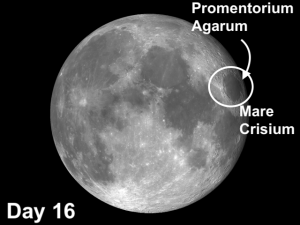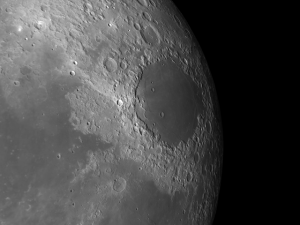 The week of August 31-Sept. 6 takes us from Lunar Day 13 to Day 19. This week we will highlight Mare Crisium and Promentorium Agarum, viewable on Thursday evening (Day 16.6).
The week of August 31-Sept. 6 takes us from Lunar Day 13 to Day 19. This week we will highlight Mare Crisium and Promentorium Agarum, viewable on Thursday evening (Day 16.6).
 Mare Crisium: [NE/H15] On Thursday evening you should be able to observe Crisium’s complexities more successfully than you did on Day 3 when the Moon was close to the horizon, particularly the high eastern mountain border. We tend to think of craters as comparatively small objects and lose sight of the fact that large lunar “seas” are the result of projectile impacts also. Basically, if it’s round, it’s a crater. Mare Crisium resulted from the impact of a large meteor 3.9 billion years ago. The event was energetic enough to leave a multi-ring imprint, parts of which we can clearly see tonight. Notice the ring features bending around Crisium on its north side. Particularly notice how Mare Anguis on the NE side of Crisium [G16] extends itself toward the west, passes below Cleomedes, and then dissipates at Tisserand. The Crisium basin appears elliptical, with its long axis running from north to south. This is an illusion due to the effects of foreshortening. Crisium actually is elliptical, but, contrary to what your eyes tell you, its long axis runs east to west.
Mare Crisium: [NE/H15] On Thursday evening you should be able to observe Crisium’s complexities more successfully than you did on Day 3 when the Moon was close to the horizon, particularly the high eastern mountain border. We tend to think of craters as comparatively small objects and lose sight of the fact that large lunar “seas” are the result of projectile impacts also. Basically, if it’s round, it’s a crater. Mare Crisium resulted from the impact of a large meteor 3.9 billion years ago. The event was energetic enough to leave a multi-ring imprint, parts of which we can clearly see tonight. Notice the ring features bending around Crisium on its north side. Particularly notice how Mare Anguis on the NE side of Crisium [G16] extends itself toward the west, passes below Cleomedes, and then dissipates at Tisserand. The Crisium basin appears elliptical, with its long axis running from north to south. This is an illusion due to the effects of foreshortening. Crisium actually is elliptical, but, contrary to what your eyes tell you, its long axis runs east to west.
Once you have become familiar with the details on the surface of Mare Crisium, particularly around Promontorium Agarum [H16] (q.v. below), be on the lookout for LTP’s. These have been reported from time to time and manifest themselves as mists that mysteriously appear and obscure some of the surrounding details.
Promontorium Agarum: [NE/H16] an impressive cape on the S.E. edge of Crisium. It has peaks that tower several thousand feet above its floor.
======================
It is highly recommended that you get a copy of Sky and Telescope’s Field Map of the Moon, the very finest Moon map available for use at the telescope. It is available for $10.95 at www.skyandtelescope.com and on Amazon. All features mentioned in this blog will be keyed to the grid on the Field Map and will look like this: Plato: [NW/D9]
Credits:
Courtesy of Gray Photography of Corpus Christi, Texas
Lunar photos: NASA / USGS / BMDO / LROC / ASU / DLR / LOLA / Moon Globe. Used by permission
- Rupes Cauchy: A Best Known Fault on the Moon - July 22, 2024
- Moon Crater Schickard – Crater Floor has Stripes - July 15, 2024
- Moon Craters Langrenus and Vandelinus - July 8, 2024